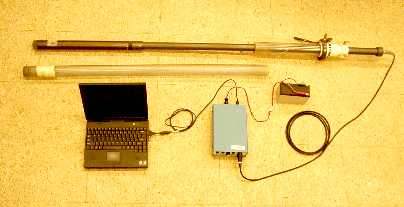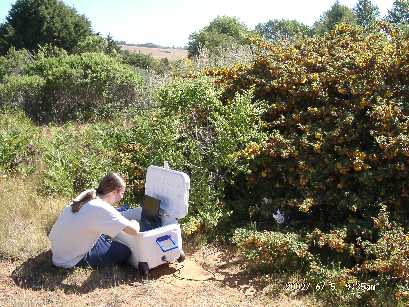A large fraction of plant-environment
interactions occur belowground, in the rhizosphere. (The rhizosphere
includes plant roots and the portion of the soil and of soil microbes
that are influenced by roots.) Unfortunately, rhizosphere processes
are nearly invisible from the surface, and excavating roots for
examination or measurement certainly alters the physiological
processes of interest. The minirhizotron camera represents an
attempt to overcome these hurdles. A transparent plastic tube
is permanently buried in the plant's root system. Then, a special
digital camera can be periodically brought to the site and lowered
into the tube. Pictures taken through the wall of the tube monitor
the growth of new roots over time. By comparing the lengths of roots
in digital images taken at different times, researchers can obtain a
quantitative estimate of a plant's allocation to root biomass over
the corresponding time period.
Minirhizotron technology
 The main technical component of this project is a state-of-the-art minirhizotron imaging system, which enables us to obtain high-quality digital images of natural phenomena occurring belowground continuously and non-destructively. The minirhizotron camera, built by the Bartz Technology
Corporation, is a specialized digital camera that can be
lowered into the tube to capture images of the tube-soil interface.
The main technical component of this project is a state-of-the-art minirhizotron imaging system, which enables us to obtain high-quality digital images of natural phenomena occurring belowground continuously and non-destructively. The minirhizotron camera, built by the Bartz Technology
Corporation, is a specialized digital camera that can be
lowered into the tube to capture images of the tube-soil interface.
Yes, that 6 foot-long device is the camera! Although rather unwieldy for
normal applications, its shape is perfect for capturing underground images.
At the top of the device is a ratcheting mechanism, built by the University of
California's machine shop, that permits the camera window to be raised or
lowered to the desired depth.
 This is our field setup. Digital
output from the camera is converted to analog in the blue box, which also controls the brightness, focus, and zoom mechanisms. The signal is then send via S-video to the computer's image grabber, where they are saved as bitmap images. Notice the tube lying near the camera; although this particular tube is used to protect the camera chassis, it is a facsimile of the tubes which are buried in the soil.
This is our field setup. Digital
output from the camera is converted to analog in the blue box, which also controls the brightness, focus, and zoom mechanisms. The signal is then send via S-video to the computer's image grabber, where they are saved as bitmap images. Notice the tube lying near the camera; although this particular tube is used to protect the camera chassis, it is a facsimile of the tubes which are buried in the soil.
 The camera in use! Santa Cruz
graduate Michael Lebeck examines the output of the minirhizotron camera. The Fremontodendron californicum at the right is one of the denizens of the UC Arboretum's California Native Plants area.
The camera in use! Santa Cruz
graduate Michael Lebeck examines the output of the minirhizotron camera. The Fremontodendron californicum at the right is one of the denizens of the UC Arboretum's California Native Plants area.